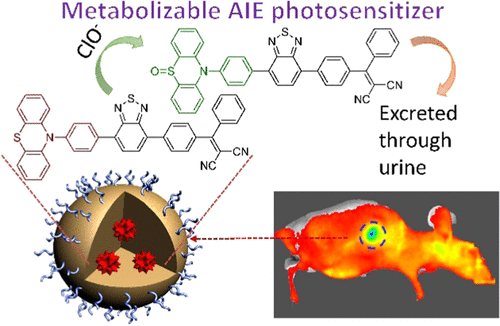当前位置:
X-MOL 学术
›
Chem. Mater.
›
论文详情
Our official English website, www.x-mol.net, welcomes your
feedback! (Note: you will need to create a separate account there.)
Metabolizable Photosensitizer with Aggregation-Induced Emission for Photodynamic Therapy
Chemistry of Materials ( IF 7.2 ) Pub Date : 2021-07-28 , DOI: 10.1021/acs.chemmater.1c01173
Wenbo Wu 1, 2 , Leilei Shi 1 , Yukun Duan 1 , Shidang Xu 1 , Xihui Gao 3 , Xinyuan Zhu 4 , Bin Liu 1, 5
Chemistry of Materials ( IF 7.2 ) Pub Date : 2021-07-28 , DOI: 10.1021/acs.chemmater.1c01173
Wenbo Wu 1, 2 , Leilei Shi 1 , Yukun Duan 1 , Shidang Xu 1 , Xihui Gao 3 , Xinyuan Zhu 4 , Bin Liu 1, 5
Affiliation

|
As a noninvasive treatment option, photodynamic therapy (PDT) offers light-controlled spatiotemporal precision. However, the current clinical practice requires the patients to avoid light exposure for days to weeks post PDT treatment due to the retention of photosensitizers (PSs) in the living body. In addition, traditional PSs suffer from quenched fluorescence and reduced 1O2 production in nanoparticles (NPs) or the aggregate state. Herein, an efficient metabolizable type-II photosensitizer FBD with aggregation-induced emission characteristics is developed and processed into NPs, which demonstrates good anti-tumor PDT efficiency in mice models. Importantly, FBD can be gradually oxidized after PDT by endogenous hypochlorite (ClO–) in the living body and subsequently excreted through urine within 24 h after PS administration. The designed metabolizable therapeutic agent addresses the key limitation of traditional PDT, showing great potential for clinical translation.
中文翻译:

用于光动力疗法的具有聚集诱导发射的可代谢光敏剂
作为一种无创治疗选择,光动力疗法 (PDT) 提供光控时空精度。然而,目前的临床实践要求患者在 PDT 治疗后数天至数周内避免光照,因为光敏剂 (PS) 会保留在活体内。此外,传统的 PS 受到荧光猝灭和纳米颗粒 (NPs) 或聚集态1 O 2产量减少的影响。在此,开发了一种具有聚集诱导发射特性的高效可代谢 II 型光敏剂FBD,并将其加工成纳米颗粒,在小鼠模型中显示出良好的抗肿瘤 PDT 效率。重要的是,在 PDT 后FBD可以被内源性次氯酸盐 (ClO– ) 在活体内,随后在 PS 给药后 24 小时内通过尿液排出。设计的可代谢治疗剂解决了传统 PDT 的关键局限性,显示出临床转化的巨大潜力。
更新日期:2021-08-10
中文翻译:

用于光动力疗法的具有聚集诱导发射的可代谢光敏剂
作为一种无创治疗选择,光动力疗法 (PDT) 提供光控时空精度。然而,目前的临床实践要求患者在 PDT 治疗后数天至数周内避免光照,因为光敏剂 (PS) 会保留在活体内。此外,传统的 PS 受到荧光猝灭和纳米颗粒 (NPs) 或聚集态1 O 2产量减少的影响。在此,开发了一种具有聚集诱导发射特性的高效可代谢 II 型光敏剂FBD,并将其加工成纳米颗粒,在小鼠模型中显示出良好的抗肿瘤 PDT 效率。重要的是,在 PDT 后FBD可以被内源性次氯酸盐 (ClO– ) 在活体内,随后在 PS 给药后 24 小时内通过尿液排出。设计的可代谢治疗剂解决了传统 PDT 的关键局限性,显示出临床转化的巨大潜力。































 京公网安备 11010802027423号
京公网安备 11010802027423号